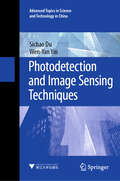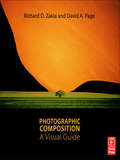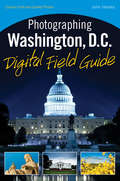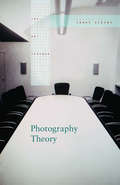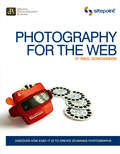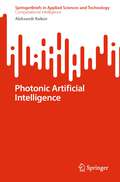- Table View
- List View
Photodetection and Image Sensing Techniques (Advanced Topics in Science and Technology in China #2)
by Sichao Du Wen-Yan YinThis book provides a comprehensive and systematic introduction to optoelectronic imaging techniques. Starting from the basis of photoelectric detection technology, it thoroughly discusses the basic knowledge of radiation measurement and light metrics, the basic principles of semiconductors, and the basic physical effects and characteristic parameters of photoelectric detection devices. It further introduces the types and characteristics of light sources commonly used in photoelectric detection. This lays a solid foundation for readers to learn the single photon detector, single photon imaging technology, and spectral imaging technology. This book also details the working principle, classification characteristics, and performance evaluation method of single-photon detectors, as well as the applications in low-light detection and quantum communication. Spectral imaging technology and two-dimensional imaging technology are also explained in terms of basic principles, system classification and characteristics. It also focuses on the practical applications of photoelectric detection technology in various fields, including remote sensing, atomic absorption spectroscopy analysis, mechanical quantity detection, etc., showing the wide application and great potential of photoelectric detection technology through specific cases. The frontiers and development trends of optoelectronic imaging technology are discussed, revealing the future development direction and challenges in this field for the readers.
Photograph Couples
by Tiffany WayneWedding and portrait photography is a vast segment of the professional portrait industry. Those who cater to this demographic know that photographing couples during a very exciting period in their lives demands a unique skill-set-these sessions are done when emotions are high, in a wide range of locations, and under a staggering array of conditions. Still, the photographer must wrangle all of the variables to create images that flatter the subjects AND tell the story of their relationship.In this book, Tiffany Wayne presents 60 high-caliber images-each paired with gorgeous alternate poses-and detailed text showing readers how each image was conceived and orchestrated to flatter the couple and show their unique relationship to best effect. In 60 two-page spreads, readers will get a behind-the-scenes look at how the image came together. Wayne discusses her intent for each image, then shows the steps used to carry out her artistic vision-from positioning the individual subjects, to creating a physical bond, and eliciting emotion. Also detailed are the compositional choices that were made to reinforce and strengthen the portrait presentation.In the first part of the book, Wayne showcases engagement portraits-images made under more relaxed conditions when the pace of the day is not as hectic as it will be on the wedding day. In the second part of the book, Wayne turns her attention to wedding portraits of the couple.With the fresh, modern feel of Tiffany Wayne's images and her casual, seemingly effortless-yet perfect-posing approach, readers will find much to emulate in this book.
Photographic Composition: A Visual Guide
by Richard D. Zakia David Page"Those of you who follow this blog know that Dr. Richard Zakia, former RIT professor, is one of my all time favorite photo gurus. We send each other pictures. We talk about looking into pictures - and not just looking at them. Big difference.. Dr. Richard Zakia, a.k.a. Dick, is the co-author, along with David Page, of Photographic Composition: A Visual Guide. These two dudes are also two of my favorite people."---Rick Sammon's blog "Covers all the tips needed to help photographers construct their own unique, outstanding images and is an outstanding 'must' for any collection."--CA Bookwatch
Photographic Rendering with V-Ray for SketchUp
by Brian BradleyThis book is filled with examples explaining the theoretical concepts behind them. Filled with ample screenshots, diagrams, and final rendered images, this book will help readers develop an understanding of photographic rendering with V-Ray. If you are a SketchUp user who would love to turn your favourite modelling application into a 'virtual photography studio', then this book has been designed and written for you. Existing V-Ray users will also find plenty to enjoy and benefit from in this book. Some basic experience with SketchUp and familiarity with photography will be helpful, but is not mandatory.
Photographing Families: Tips for Capturing Timeless Images
by Michele CelentanoCreate family portraits to cherish for a lifetime Family photographs are a staple of both amateur and professional photography. While always in demand, they also pose a unique set of challenges. In this book, Canon Explorer of Light Michele Celentano guides beginning- to intermediate-level photographers around the common pitfalls and helps them learn how to get top-quality shots every time. From getting families organized and directing the posing to managing large groups and impatient kids, this book reveals the secrets and helps you capture the shot without relying on post-production to achieve perfection. Whether you're a professional seeking to advance your knowledge or the family's designated picture-taker, you'll benefit from these professional tips. You'll learn camera techniques that can take pounds and years off your subjects and create images that stand the test of time. Family pictures are a photographic staple with their own set of challenges; this book offers tried-and-true advice for both hobbyists and professionals Veteran photographer and Canon Explorer of Light Michele Celentano guides you through getting families prepared for a photo session, directing the poses, handling challenging personalities, and creating memorable settings Helps you capture the perfect shot in the camera without relying on post-production to make it right Reveals secrets that can help your subjects shed pounds and years Packed with advice to help you keep your photos from showing up on awkwardfamilyphotos.com Photographing Families: Tips for Capturing Timeless Images is loaded with insider tips to help you make family portraits the treasure they should be.
Photographing Flowers: Exploring Macro Worlds with Harold Davis
by Harold DavisCapture stunning macro floral images with this gorgeous guide by acclaimed photographer Harold Davis. You'll learn about different types of flowers, macro equipment basics, and the intricacies of shooting different floral varieties in the field and in the studio. Harold also shows you techniques in the Photoshop darkroom that can be applied to flower photography to help you get the most out of your images. Beautiful and authoritative, this guide to photographing flowers is a must-read for every photographer interested in flower photography. Photographing Flowers will also win a place in the hearts of those who simply love striking floral imagery.
Photographing New York City Digital Field Guide
by Andy Williams Jeremy PollackTake memorable photos of the most popular attractions in the Big Apple!Whether using a point-and-shoot or a high-end dSLR, this companion guide provides you with detailed information for taking amazing shots of one of one of the world's most photographed cities. Whether you aim to capture the regal Empire State Building, vibrant Times Square, historic Grand Central Station, massive Central Park, or one of New York City's many other landmarks, this portable resource goes where you go and walks you through valuable tips and techniques for taking the best shot possible. You'll discover suggested locations for taking photos, recommended equipment, what camera settings to use, best times of day to photograph specific attractions, how to handle weather challenges, and more. In addition, beautiful images of New York City's most breathtaking attractions and recognizable landmarks serve to both inspire and assist you as you embark on an amazing photographic adventure!Elevates your photography skills to a new level with photography secrets from professional photographer and SmugMug COO, Andy Williams Presents clear, understandable tips and techniques that span all skill levels, using all types of digital cameras, from full-featured compact cameras to high end DSLRsFeatures New York City's main attractions in alphabetical order as well as thumb tabs on the pages so you can quickly and easily access the information you are looking forShares detailed information and insight on critical topics, such as ideal locations to photograph from, the best time of day to shoot, camera equipment to have handy, weather conditions, and optimal camera settings to considerWhether you're a local familiar with the territory or a visitor seeing the Big Apple for the first time, this handy guide will help you capture fantastic photos!
Photographing Newborns
by Mimika CooneyIn this comprehensive book, Cooney touches on each facet of being a successful newborn portrait photographer. She begins by outlining the foundation of her business model and provides insight for the reader to establish something similar for their business. Defining your target market and ideal customer profile are essential to guiding your business in the right direction. Cooney focuses her business, and this book, on what she calls a 'boutique’ brand. These are pricier photo shoots and packages, which require more time and care. Working with clients at this level often creates a lasting relationship and hopefully, repeat business. This is where the branding of your business is so important. Not only can it deliver regular clients, but can also inspire important word-of-mouth references. Emphasizing how important it is for a photography studio to have structure and direction to become and remain successful, Cooney walks the reader through many scenarios that have helped form her business. A strong social media presence, creative marketing & promotions and repeat customers are the key to standing apart from the competition, therefor remaining vital.
Photographing San Francisco Digital Field Guide
by Bruce SawleA compact, full-color companion guide to photographing San Francisco! Whether using a full-featured compact camera or a high-end dSLR, this companion guide provides you with detailed information for taking stunning shots of beautiful San Francisco. Whether you aim to capture breathtaking photos of the majestic Golden Gate Bridge, crooked Lombard Street, infamous Alcatraz, or unique Victorian homes, this portable resource goes where you go and walks you through valuable tips and techniques for taking the best shot possible. You'll discover suggested locations for taking photos, recommended equipment, what camera settings to use, best times of day to photograph specific attractions, how to handle weather challenges, and more. In addition, lovely images of San Francisco's most breathtaking attractions and recognizable landmarks serve to both inspire and assist you as you embark on an amazing photographic adventure! Elevates your photography skills to a new level with photography secrets from professional photographer Bruce Sawle Presents clear, understandable tips and techniques that span all skill levels, using all types of digital cameras, from compacts to high end DSLRs Features San Fransisco's main attractions in alphabetical order as well as thumb tabs on the pages so you can quickly and easily access the information you are looking for Shares detailed information and insight on critical topics, such as ideal locations to photograph from, the best time of day to shoot, camera equipment to have handy, weather conditions, and optimal camera settings to consider Whether you're a local familiar with the territory or a visitor seeing San Francisco for the first time, this handy guide will help you capture fantastic photos!
Photographing Washington, D.C. Digital Field Guide
by John HealeyThe ideal companion guide for capturing awe-inspiring photos of Washington, D. C. ! Whether using a compact camera or a high-end dSLR, this companion guide provides you with detailed information for taking spectacular shots of some of the most recognizable architecture in the world. Whether you aim to capture memorable photos of the White House, U. S. Capitol, Washington Monument, Lincoln Memorial, or one of D. C. 's other many remarkable memorials, this portable resource goes where you go and walks you through valuable tips and techniques for taking the best shot possible. You'll discover suggested locations for taking photos, recommended equipment, what camera settings to use, best times of day to photograph specific attractions, how to handle weather challenges, and more. In addition, beautiful images of Washington, D. C. 's most breathtaking attractions and recognizable landmarks serve to both inspire and assist you as you embark on an amazing photographic adventure! Elevates your photography skills to a new level with photography secrets from professional photographer John Healey Presents clear, understandable tips and techniques that span all skill levels, using all types of digital cameras, from compact cameras to high end DSLRs Features Washington, D. C. 's main attractions in alphabetical order as well as thumb tabs on the pages so you can quickly and easily access the information you are looking for Shares detailed information and insight on critical topics, such as ideal locations to photograph from, the best time of day to shoot, camera equipment to have handy, weather conditions, and optimal camera settings to consider Whether you're a local familiar with the territory or a visitor seeing our nation's capital for the first time, this handy guide will help capture fantastic photos!
Photographing Waterdrops: Exploring Macro Worlds with Harold Davis
by Harold DavisCapturing the fleeting, dynamic world contained within the tiniest of water droplets is one of the most challenging photographic endeavors. Like many things, the challenge is worth the effort - when done with skill, these images can become some of the most unique shots you've ever taken. In this gorgeous guide packed with creative insipration alongside technical expertise, award-winning photographer Harold Davis shows you how he creates his stunning water drop images. From challenges to working with constantly moving subjects and reflected light to basic info on which equipment works best, this book will help all macro-loving photographers turn their lens on water, water, everywhere.
Photographing Yosemite Digital Field Guide
by Lewis KemperThe ideal companion guide for capturing awe-inspiring photos of Yosemite! Whether using a compact camera or a high-end dSLR, this companion guide provides you with detailed information for taking spectacular shots of some of the most recognizable landmarks in the world. Whether you aim to capture memorable photos of Half Dome, El Capitan, Vernal Fall, Mariposa Grove, or one of Yosemite's other many remarkable attractions, this portable resource goes where you go and walks you through valuable tips and techniques for taking the best shot possible. You'll discover suggested locations for taking photos, recommended equipment, what camera settings to use, best times of day to photograph specific attractions, how to handle weather challenges, and more. In addition, beautiful images of Yosemite's most breathtaking attractions and recognizable landmarks serve to both inspire and assist you as you embark on an amazing photographic adventure! Elevates your photography skills to a new level with photography secrets from professional photographer Lewis Kemper Presents clear, understandable tips and techniques that span all skill levels, using all types of digital cameras, from compact cameras to high end DSLRs Features Yosemite's main attractions in alphabetical order as well as thumb tabs on the pages so you can quickly and easily access the information you are looking for Shares detailed information and insight on critical topics, such as ideal locations to photograph from, the best time of day to shoot, camera equipment to have handy, weather conditions, and optimal camera settings to consider Whether you're a local familiar with the territory or a visitor seeing this beautiful U. S. National Park for the first time, this handy guide will help capture fantastic photos!
Photographing the Elements: Capturing Nature's Most Extreme Phenomena With Your Digital Camera
by Gary Eastwood Joseph MeehanBlizzards, tornados, volcanic eruptions, and desert sandstorms? Forget about seeking shelter - these are the prime times to grab your gear and get one-of-a-kind photographs of the most exotic and extraordinary subjects on earth. Miles away from your typical landscape and nature shots, these powerful images are a stunning survey of natural wonders, a vibrant addition to any portfolio, and a testament to the adventurous spirit of the extreme photographer. Get out of your comfort zone and embrace the elements!
Photographing the Female Form with Digital Infrared
by Laurie KleinPhotographing female nudes is about more than just the body. For Laurie Klein, it is about capturing the feminine spirit. Laurie's creative medium is nature. The landscape plays as much of a role in her photos as does the model. Laurie's unique way of using infrared photography, and the caring, personal way she captures her subject's innermost emotions becomes a transformational experience for both photographer and client. In this book, Klein details her techniques and her inspirations in creating these unforgettable images.Shooting nudes in nature is complex. The photographer needs to know when to start with the model and arrange nature around them or see something in nature and treat the model as part of the nature. Klein gives many ideas for posing models in relationship to nature and the landscape. She masterfully uses infrared photography to capture the beauty of the surroundings and the female form. Each photo in the book is accompanied by details of the location or setting, camera settings, composition concepts and insight into the idea and execution of the shot.Part of what makes Klein's photos so unique and vibrant is that she develops a trusting environment that allows the subject to give themselves over completely to a transcendent photographic experience. Out of this usually comes a series of fine art portraits or a substantial book for them to enjoy, share and pass on through the generations.Using the body as a landscape, Klein crafts unique and sometimes abstract images that emphasize the beauty of the female form in different ways. Sometimes the simplicity of the image is the beauty of it. The infrared photography format provides striking contrasts between the skin tones and the natural surroundings. Tips are given for choosing unique locations that can work best for creating artful images like the ones in the book. Being able to improvise and set-up a shoot when discovering a unique setting or lighting scenario can be the key to crafting a stunning portrait. Sometimes the unexpected can occur and a prepared and creative photographer can turn that into a magical moment captured in infrared.Klein is recognized for her signature infrared photography style. This book provides in insight into her creative process.
Photographing the Female Form with Digital Infrared
by Laurie KleinPhotographing female nudes is about more than just the body. For Laurie Klein, it is about capturing the feminine spirit. Laurie's creative medium is nature. The landscape plays as much of a role in her photos as does the model. Laurie's unique way of using infrared photography, and the caring, personal way she captures her subject's innermost emotions becomes a transformational experience for both photographer and client. In this book, Klein details her techniques and her inspirations in creating these unforgettable images.Shooting nudes in nature is complex. The photographer needs to know when to start with the model and arrange nature around them or see something in nature and treat the model as part of the nature. Klein gives many ideas for posing models in relationship to nature and the landscape. She masterfully uses infrared photography to capture the beauty of the surroundings and the female form. Each photo in the book is accompanied by details of the location or setting, camera settings, composition concepts and insight into the idea and execution of the shot.Part of what makes Klein's photos so unique and vibrant is that she develops a trusting environment that allows the subject to give themselves over completely to a transcendent photographic experience. Out of this usually comes a series of fine art portraits or a substantial book for them to enjoy, share and pass on through the generations.Using the body as a landscape, Klein crafts unique and sometimes abstract images that emphasize the beauty of the female form in different ways. Sometimes the simplicity of the image is the beauty of it. The infrared photography format provides striking contrasts between the skin tones and the natural surroundings. Tips are given for choosing unique locations that can work best for creating artful images like the ones in the book. Being able to improvise and set-up a shoot when discovering a unique setting or lighting scenario can be the key to crafting a stunning portrait. Sometimes the unexpected can occur and a prepared and creative photographer can turn that into a magical moment captured in infrared.Klein is recognized for her signature infrared photography style. This book provides in insight into her creative process.
Photographs from the Edge: A Master Photographer's Insights on Capturing an Extraordinary World
by Art Wolfe Rob SheppardLegendary nature photographer Art Wolfe presents an intimate, behind-the-scenes guide to the experiences, decisions, and methods that helped him capture images from some of the most exciting locations across the globe. Wolfe takes you from the mountains of the Himalayas to the sandy shores of Mnemba Island, with stops in the crowded streets of India and the alkali lakes of Africa along the way. You'll learn the equipment, settings, and creative choices behind each photograph. From endangered species to cultural celebrations to natural wonders, Wolfe brings each subject to life through his stunning photography and the stories he shares in this one-of-a-kind photo safari.From the Hardcover edition.
Photography Careers: Finding Your True Path
by Mark JenkinsonPhotography Careers offers students an indispensable guide to beginning their professional journeys as photographers. This book presents the variety of career options available to those entering the competitive and comprehensive world of photography. With the insight and advice from industry mavens and the author himself, Photography Careers will help you change the way you evaluate your strengths as an artist and find your place in the photography community. Features include: Interviews with successful young professional photographer in a wide range of photographic specialties, from fashion photography to cinematography, and other industry related fields such as retouching, fine art sales, and photo editing Tips for how to find unique approaches in a saturated market Best practices for student looking at graduate programs, a budding career, and as a personal business
Photography Reframed: New Visions in Contemporary Photographic Culture (International Library Of Visual Culture Ser.)
by Ben BurbridgeAt a critical point in the development of photography, this book offers an engaging, detailed and far-reaching examination of the key issues that are defining contemporary photographic culture. Photography Reframed addresses the impact of radical technological, social and political change across a diverse set of photographic territories: the ontology of photography; the impact of mass photographic practice; the public display of intimate life; the current state of documentary, and the political possibilities of photographic culture. These lively, accessible essays by some of the best writers in photography together go deep into the most up-to-date frameworks for analysing and understanding photographic culture and shedding light on its histories. Photography Reframed is a vital road map for anyone interested in what photography has been, what it has become, and where it is going.
Photography Theory (The Art Seminar)
by Jame ElkinsPhotography Theory presents forty of the world's most active art historians and theorists, including Victor Burgin, Joel Snyder, Rosalind Krauss, Alan Trachtenberg, Geoffrey Batchen, Carol Squiers, Margaret Iversen and Abigail Solomon-Godeau in animated debate on the nature of photography. Photography has been around for nearly two centuries, but we are no closer to understanding what it is. For some people, a photograph is an optically accurate impression of the world, for others, it is mainly a way of remembering people and places. Some view it as a sign of bourgeois life, a kind of addiction of the middle class, whilst others see it as a troublesome interloper that has confused people's ideas of reality and fine art to the point that they have difficulty even defining what a photograph is. For some, the whole question of finding photography's nature is itself misguided from the beginning. This provocative second volume in the Routledge The Art Seminar series presents not one but many answers to the question what makes a photograph a photograph?
Photography as Activism: Images for Social Change
by Michelle BogreYou want to look through the lens of your camera and change the world. You want to capture powerful moments in one click that will impact the minds of other people. Photographic images are one of the most popular tools used to advocate for social and environmental awareness. This can be as close to home as drug use, prostitution, or pollution or as far away as famine, war, and the plight of refugees and migrant workers. One well-known example of an activist photographer would be landscape photographer Ansel Adams, who trudged to Washington with stunning images of the American west to advocate protecting these areas. His images and testimony were instrumental in creating the National Park System and garnering specific protection for Yellowstone National Park. More recently Robert Glenn Ketchum's images of Alaska's Arctic National Wildlife Refuge raised awareness of why this area should be protected. Nigel Barker's seal photographs advocates against seal clubbing. What is your cause and how can you use your camera to make the world a better place?This book provides a comprehensive theory of, and history of, photography as activism. It also includes interviews with contemporary photographers. It is a call to action for young photographers to become activists, a primer of sorts, with advice for how to work with NGOs and non-profits, how to work safely in conflict zones and with suggestions for distribution on websites, blogs, and interactive agencies.
Photography as Activism: Images for Social Change
by Michelle BogreThis fully revised and updated second edition of Photography as Activism is both a study of activist photography, and a call to action. It offers students and documentary photographers insights into the theory, history, philosophy, and practice of photography as activism.The book is lavishly illustrated with 85 key historical and contemporary images. Chapters have been revised to include contemporary ideas about representation, gaze, agency, and decolonizing the camera, as well as an expanded history that includes work from the global South and the civil rights movements in the US. A new fourth chapter focuses on activist practices that go beyond traditional reportage. It features 19 new interviews and updates on the original interviews. Photographers talk about their practices, the challenges they face in the twenty-first century, advice on working with NGOs and non-profits, and how to form partnerships to expand the dissemination of their work.Photography as Activism is an essential text for courses on documentary and photojournalism, and those that explore art as social change more broadly, but also a call to action for young photographers to pick up their cameras and advocate for change.
Photography for Kids!
by Sandra Abend Michael EbertDigitization is the biggest advance in the history of photography. While some seasoned photographers may still be wary of the filmless technique, unbiased children have easily found their way into the digital world. Children are excited by the instant gratification of capturing an image and immediately seeing the result. With today's digital cameras, what used to be an expensive and disappointing process is now as easy as pie. Enthusiastic and confident children are able to handle digital cameras with remarkable skill. The instant feedback motivates them to continue exploring, and soon they are able to create small masterpieces full of inspiration and fantasy. Photography for Kids introduces children between the ages of 8 and 14 to the world of photography. Technical concepts--like how a digital camera actually works--are explained in a way that is easy for children to understand. The book emphasizes creativity and presents techniques for capturing exciting images.
Photography for the Web: Discover How Easy It Is To Create Stunning Photographs (Sitepoint Ser.)
by Paul DuncansonA hands-on on guide to digital photography, with a practical focus on the Web. Readers will learn how to make the most of their digital camera, while learning the basics of composition, exposures, filters and more.Step-by-step guides will walk readers through advance techniques like using long exposures, photographing items in motion, and the importance of the RAW data format."Photography for the Web" will also offer helpful advice on editing images (levels, colors, histograms), correcting for barrel distortions and vanishing points, removing blemishes, going black & white and stitching panoramas.Finally, the book will discuss sharing images online, utilizing online communities like Flickr & Fotalia, competitions for amateur photographers and selling photos on stock image sites like iStockPhoto.
Photography, Temporality, and Modernity: Time Warped (Routledge History of Photography)
by Kris Belden-AdamsThis book examines the photography’s unique capacity to represent time with a degree of elasticity and abstraction. Part object-study, part cultural/philosophical history, it examines the medium’s ability to capture and sometimes "defy" time, while also traveling as objects across time-and-space nexuses. The book features studies of understudied, widespread, practices: studio portraiture, motion studies, panoramas, racing photo finishes, composite college class pictures, planetary photography, digital montages, and extended-exposure images. A closer look at these images and their unique cultural/historical contexts reveals photography to be a unique medium for expressing changing perceptions of time, and the anxiety its passage provokes.
Photonic Artificial Intelligence (SpringerBriefs in Applied Sciences and Technology)
by Aleksandr RaikovThis book addresses an attempt to create Photonic Artificial Intelligence (PAI) system based on optical technologies, which process signals continuously. PAI could help to overcome digital computer limits and almost zero out the machine learning time and AI inference. It helps to consider feelings, the chaos of thoughts, cognitive activity, and the transcendental states of the human mind in AI systems. The book also discusses new problems such as synthesizing new photonic materials, creating optical control systems, and connecting PAI systems with outside digital computers and holographic memory. The book is aimed at a wide range of readers, including postgraduates and researchers, interested in advanced AI by creating its new paradigm, which can help to overcome traps of traditional AI development.
